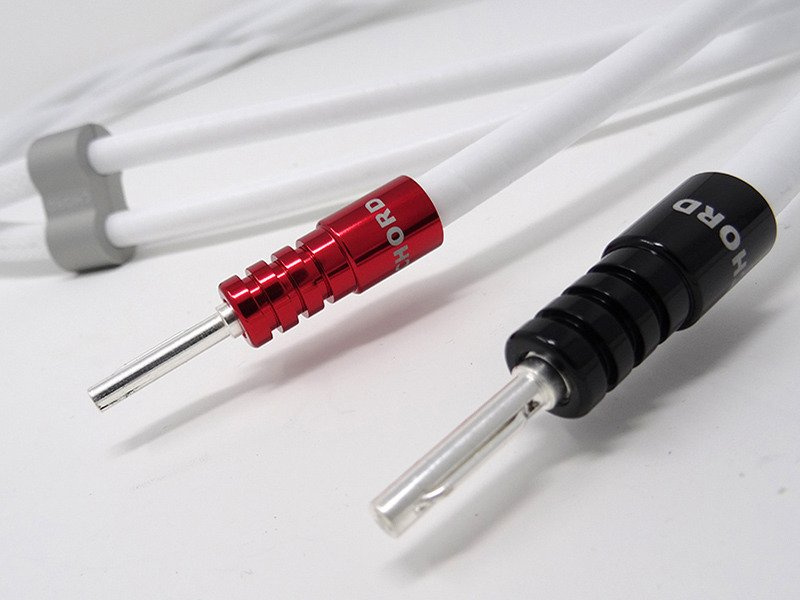Chord Sarum T - single-wire - banana
- Sarum speaker cable uses very high quality silver-plated copper conductors and lots of them. It’s a properly heavy speaker cable with an extremely low resistance measurement.
Chord Sarum T - single-wire - banana
The original Chord Sarum was our most invisible speaker cable, designed (like all Chord cables) to have minimal effect on the audio signal. Every element of the build needs to be considered.
Sarum T builds on the success of its award-winning predecessor and introduces our breakthrough proprietary insulation material, Taylon®, bringing a major performance upgrade. Sarum T brings the remarkable benefits of our proprietary dielectric at a new, more accessible price level. Previous generations of Sarum Super ARAY cables have featured a PTFE dielectric. The upgrade to Taylon® introduces a raft of performance benefits.
Dedicated bi-wire links are also available, which replace the pressed metal links supplied with bi-wire loudspeakers.
Sarum retailers all have demonstration sets of cable that you can take home and try. When you do try it, just remember that it’s your music collection you’re listening to, not your hi-fi and not the speaker cable.
This speaker cable is built to order and sold in terminated sets from £1800 for a 1.5m pair.
Specifications:
- Conductor High purity, silver-plated, polished OFC
- Insulation Taylon
- Configuration Twisted pair
- Shielding Individually shielded positive and minus conductors. Silver-plated ribbon braid and heavy foil. Polyethylene outer jacket
- AWG 12 (2.63 mm2)
- Diameter 2 x 8.5mm
Chord Ohmic 4mm Silver Banana Plugs
Our new ChordOhmic silver-plated loudspeaker plugs are designed to bring both the electrical and sonic benefits of silver to speaker cables everywhere. The new plugs will be fitted to all Chord Company speaker cables, as well as being separately available as a retro-fit upgrade, enabling this revolutionary 4mm connector to improve other brands of cable, too.
For many years we have been using silver-plated copper conductors in our designs. Our silver-plated designs are paired with silver-plated connectors. Using silver in cables can be misunderstood, as many people still associate the use of silver with a bright, overbearing sound characteristic. In our experience, however, this brightness is actually caused by a poor choice of insulation material rather than the silver! The only major exception to this rule has been Chord Company gold-plated (4mm/spade) speaker connectors.
Why not gold?
Although gold is generally perceived to be the best plating material for high-quality connectors, its only major advantage is its total resistance to corrosion (not normally a domestic issue!). In our experience, the customer also associates it with performance and quality due to gold’s high commercial value. Matters are further complicated by the various other plating materials on offer in the hi-fi industry (e.g. rhodium, copper, brass and nickel) with each having wildly differing prices and claimed performance levels.
Science, statistics and misinformation as we see it!
Gold is, in fact, the third most conductive metal available. It is outperformed by both copper (+140% better) and silver (+148% better). Better conductivity means lower resistance and therefore, less signal loss. Less signal loss means increased performance – as expressed by Ohm’s law! Hence the name of our new speaker plugs.
Although pure copper is a good conductor, at room temperature it is susceptible to oxidisation and drastically drops in conductivity when oxidised. Plating the copper can protect it from this process. Plating materials include tin (25% as good as gold), nickel (33% as good as gold) and rhodium (50% as good as gold).
Crucially, silver-plating not only makes sense from an electrical point of view, it gives an audibly superior result during listening tests, when compared with gold plated connectors.
What about tarnish?
It’s a common mistake to think that because silver oxidises it is a poor conductor. The reality is that silver does not oxidise until it reaches 170 C. It does, however, tarnish at room temperature, reacting with sulphur in the air.
Although tarnished silver is not the nicest thing to look at (on ornaments or cutlery), electrically, it is less troublesome.
Tarnish (normally silver sulphide) is a soft and malleable material and can be easily moved aside with very little force. We ensure these forces are present in our speaker plugs and spade connectors. The diagram below illustrates the fact that no matter how smooth a contact looks to the naked eye, it is still quite rough at a microscopic level. There are limited points of actual contact, even under fairly high levels of force. By simply moving a connector in and out of the socket, it is possible to effectively clean the contact points. Ensure all equipment is switched off before doing this simple maintenance procedure.
Plugs will also benefit from a major clean, using a good contact cleaner or enhancer.

Above: Top section shows a low compression connection. Lower section shows the deformation of the plug and socket when compressed together. This compression displaces the soft tarnish as well as increasing the contact area.







